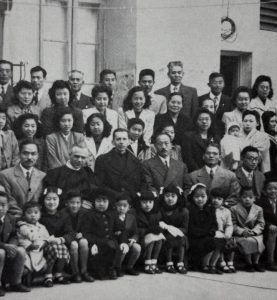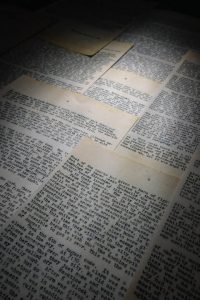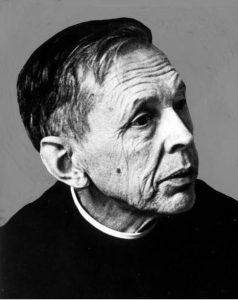Documenting Hiroshima 80 years after A-bombing: In December 1947, A-bomb survivor priest returns to city, envisions cathedral for world peace
Feb. 1, 2025
by Michio Shimotaka, Staff Writer
In December 1947, a priest who had experienced the atomic bombing in the city returned to Hiroshima after traveling in Europe and South America over a period of one year and four months. Father Hugo Lassalle, 49 at the time, was a priest at the Catholic Noboricho Church (in the city’s present-day Naka Ward) who died in 1990 at the age of 91. Father Lassalle, a pioneer in the communication of A-bombing experiences in other nations, traveled around the world explaining his vision of establishing a cathedral in Hiroshima that would be dedicated to peace.
The Chugoku Shimbun dated December 11, 1947, introduced Father Lassalle under the headline, “A pilgrimage to ‘the edge of the world’ with the aim of explaining ‘pika-don’ (an expression in Japanese used to describe the flash [‘pika’] and blast [‘don’] from the atomic bombing).” He first visited Europe to attend the general congregation of the Society of Jesus in August 1946, after which he engaged in several-hundred speaking engagements. Recalling that journey, he described how, “People in other countries showed such great interest in the atomic bombings that, everywhere I went, people grabbed me to speak about what had happened at the time of the bombing.”
A native of Germany, Father Lassalle came to Japan in 1929. He experienced the bombing five years after he began serving at the Noboricho Church. According to his 1948 personal account titled “What I Have Seen,” on the morning of August 6, 1945, he had been in the parish house of the church, located around 1.2 kilometers from the hypocenter. He wrote, “Quite suddenly, a strange light flashed outside and inside the house.” The structure did not collapse, but he did suffer severe injuries to his left leg.
Amid “fires that had broken out here and there,” he worked to help free people who were trapped under buildings nearby. Accompanied by others including Father Klaus Luhmer, who had similarly saved him and who died in 2011 at the age of 94, Father Lassalle fled to the Jesuit Novitiate at Nagatsuka (in Hiroshima’s present-day Asaminami Ward), on the outskirts of Hiroshima.
Rushed to rebuild church
After the war, he accelerated his efforts to rebuild the church with other priests who had survived the bombing. In December 1945, he returned to a small, three tatami-mat shack on the site in the city that served as both a sleeping area and church. In June 1946, he began work on reconstruction of the parish house. At the same time, he built out his vision of a “memorial cathedral.”
In “What I Have Thought,” another personal account written in 1948, Father Lassalle described the thoughts he arrived at after resolving his internal conflict about why he had been saved while countless other lives had been taken in the bombing. “The thought came to me that something should be done for the deceased, something in remembrance of them. These thoughts soon developed to the idea of a memorial cathedral,” he wrote in the account.
Father Lassalle had presented the memorial cathedral concept at a number of nations he was visiting on his journey that had begun in August 1946, such as the United States, the nation that had dropped the atomic bombs, France, Spain, and Argentina. He described how in a meeting in September of that year, he had explained the concept to Pope Pius XII and received his support.
To honor memory of victims
In explaining the idea, he included the founding principles for the cathedral as being not only to honor the memory of A-bomb victims but also to pray for world peace. Shoji Fukahori, 87, a priest at the Society of the Light of the Gospel, in Hatsukaichi City, who had attended Noboricho Church since the fall of 1944, recalled the personality of Father Lassalle as being that of “a sociable person.” Mr. Fukahori shared his views about the concept of praying for world peace from the A-bombed city. “The origin of the word ‘catholic’ is derived from the meaning ‘universal.’ He was broad-minded and embodied the spirit of Catholicism.”
After returning to Hiroshima, Father Lassalle said in remarks printed in the Chugoku Shimbun dated December 11, 1947, “People around the world hoped that Japan would never stage an unnecessary war again.” In 1948, he obtained Japanese nationality and took the Japanese name Makibi Enomiya. He accelerated his activities to construct the Memorial Cathedral for World Peace, which was completed in 1954 and later designated a national important cultural asset.
(Originally published on February 1, 2025)
In December 1947, a priest who had experienced the atomic bombing in the city returned to Hiroshima after traveling in Europe and South America over a period of one year and four months. Father Hugo Lassalle, 49 at the time, was a priest at the Catholic Noboricho Church (in the city’s present-day Naka Ward) who died in 1990 at the age of 91. Father Lassalle, a pioneer in the communication of A-bombing experiences in other nations, traveled around the world explaining his vision of establishing a cathedral in Hiroshima that would be dedicated to peace.
The Chugoku Shimbun dated December 11, 1947, introduced Father Lassalle under the headline, “A pilgrimage to ‘the edge of the world’ with the aim of explaining ‘pika-don’ (an expression in Japanese used to describe the flash [‘pika’] and blast [‘don’] from the atomic bombing).” He first visited Europe to attend the general congregation of the Society of Jesus in August 1946, after which he engaged in several-hundred speaking engagements. Recalling that journey, he described how, “People in other countries showed such great interest in the atomic bombings that, everywhere I went, people grabbed me to speak about what had happened at the time of the bombing.”
A native of Germany, Father Lassalle came to Japan in 1929. He experienced the bombing five years after he began serving at the Noboricho Church. According to his 1948 personal account titled “What I Have Seen,” on the morning of August 6, 1945, he had been in the parish house of the church, located around 1.2 kilometers from the hypocenter. He wrote, “Quite suddenly, a strange light flashed outside and inside the house.” The structure did not collapse, but he did suffer severe injuries to his left leg.
Amid “fires that had broken out here and there,” he worked to help free people who were trapped under buildings nearby. Accompanied by others including Father Klaus Luhmer, who had similarly saved him and who died in 2011 at the age of 94, Father Lassalle fled to the Jesuit Novitiate at Nagatsuka (in Hiroshima’s present-day Asaminami Ward), on the outskirts of Hiroshima.
Rushed to rebuild church
After the war, he accelerated his efforts to rebuild the church with other priests who had survived the bombing. In December 1945, he returned to a small, three tatami-mat shack on the site in the city that served as both a sleeping area and church. In June 1946, he began work on reconstruction of the parish house. At the same time, he built out his vision of a “memorial cathedral.”
In “What I Have Thought,” another personal account written in 1948, Father Lassalle described the thoughts he arrived at after resolving his internal conflict about why he had been saved while countless other lives had been taken in the bombing. “The thought came to me that something should be done for the deceased, something in remembrance of them. These thoughts soon developed to the idea of a memorial cathedral,” he wrote in the account.
Father Lassalle had presented the memorial cathedral concept at a number of nations he was visiting on his journey that had begun in August 1946, such as the United States, the nation that had dropped the atomic bombs, France, Spain, and Argentina. He described how in a meeting in September of that year, he had explained the concept to Pope Pius XII and received his support.
To honor memory of victims
In explaining the idea, he included the founding principles for the cathedral as being not only to honor the memory of A-bomb victims but also to pray for world peace. Shoji Fukahori, 87, a priest at the Society of the Light of the Gospel, in Hatsukaichi City, who had attended Noboricho Church since the fall of 1944, recalled the personality of Father Lassalle as being that of “a sociable person.” Mr. Fukahori shared his views about the concept of praying for world peace from the A-bombed city. “The origin of the word ‘catholic’ is derived from the meaning ‘universal.’ He was broad-minded and embodied the spirit of Catholicism.”
After returning to Hiroshima, Father Lassalle said in remarks printed in the Chugoku Shimbun dated December 11, 1947, “People around the world hoped that Japan would never stage an unnecessary war again.” In 1948, he obtained Japanese nationality and took the Japanese name Makibi Enomiya. He accelerated his activities to construct the Memorial Cathedral for World Peace, which was completed in 1954 and later designated a national important cultural asset.
(Originally published on February 1, 2025)










